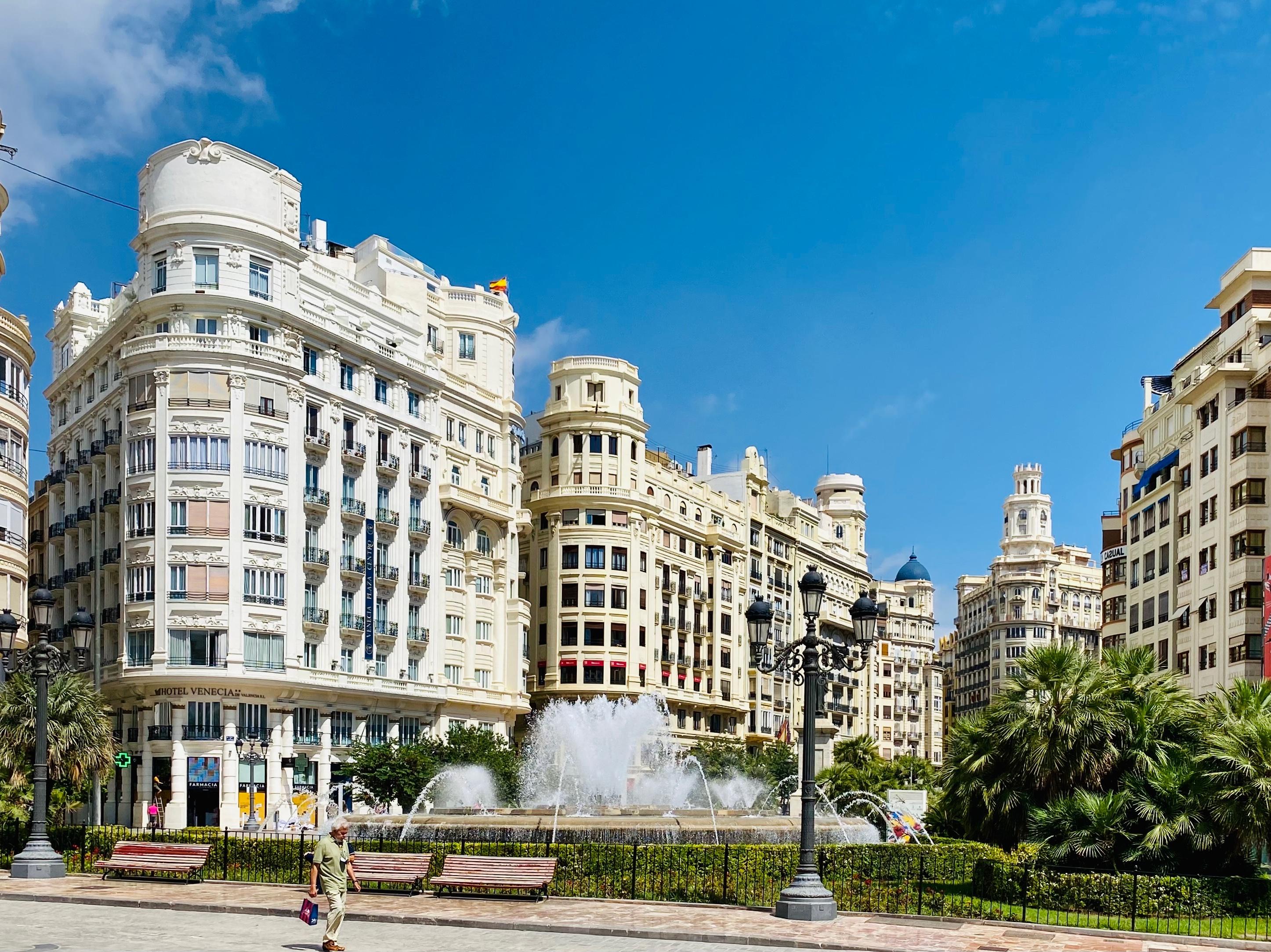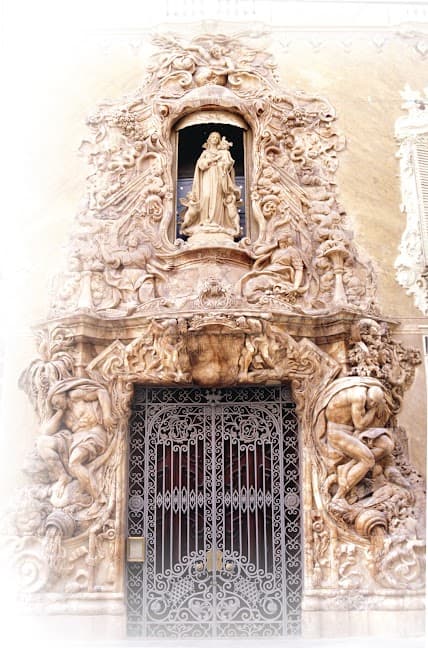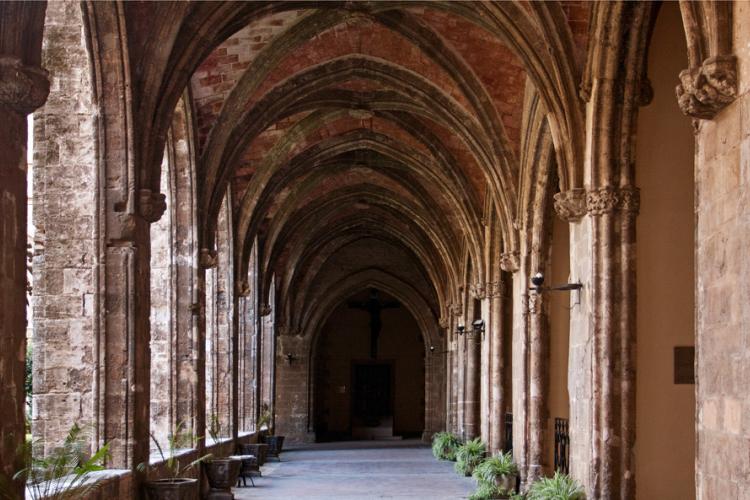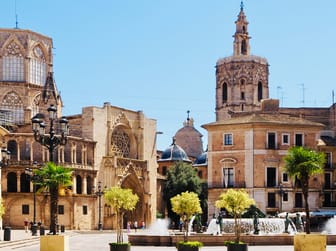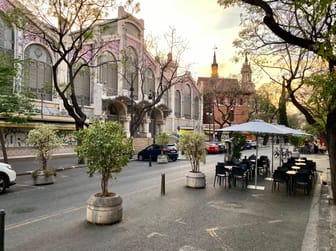EAT + DRINK
SEE + DO
CIUTAT VELLA
Valencians call their historic central district La Ciutat Vella. The Old City, as the 1st district's name translates in Valenciano (the local language similar to Catalan), is comprised of 6 neighborhoods or barrios: El Carme, La Seu, La Xerea, Sant Francesc, El Mercat, and El Pilar.
Map creator: Mike Hall on Behance.com
Always check hours and closure days. Keep in mind that Spanish days start later—many sites don't open until 10 am—but markets open (and close) early. Rearrange to suit individual needs.
Focus on San Francesc along the south end of La Ciutat Vella, along with quieter La Xerea to the east.
Sant Francesc
The spacious neighborhood of Sant Francesc centers around the huge City Hall plaza on the south end of Ciutat Vella. Much of it feels grand and commercial. Many hotels are found here. Between it all are great restaurants and quaint streets.
Ancient Hospital Public Library and Gardens
@aligiaudrone
Biblioteca Pública de València Pilar Faus, an ancient hospital-turned-public library, sits within the large antiquity gardens, Jardins de l'Antic Hospital, at the far western edge of Sant Francesc, just south of El Pilar.
Two museums adjacent to the gardens are the MuVIM, Museo Valenciano de la Ilustración y la Modernidad, which exhibits the evolution of modern thought including a replica of the city during the 18th century, and Museu i Col·legi de l'Art Major de la Seda, a restored 15th-century Gothic building with a silk museum.

Details
Plaça de L'Ajuntament (City Hall)
Grand architecture, museums, restaurants, and shops surround one of the biggest and busiest plazas in the center of Sant Francesc at Plaza del Ayuntamiento, once the site of a monastery, today mostly space for pedestrians and celebrations.
Museo Histórico Municipal de Valencia
@aligiaudrone
Municipal History Museum that houses the "Senyera" flag of Valencia and Catalonia, the "Pendón de la Reconquista" banner used during the reclamation of land from the Moors, the sword of Jaume I, a plan of Valencia from 1704, a 15th-century Flemish painting, tapestries, and priceless books from La Lonja such as the Consolat del Mar, Llibre dels Furs and La Taula de Canvis.

Details
Correus
@aligiaudrone
Also known as Palacio de Correos, this "postal palace" is now a museum as a piece of public heritage and no longer functions as the post office headquarters that was built in 1923 by modernist architect Miguel Ángel Navarro in the Valencian Art Nouveau style.

Details
✨ MUST-SEE HIGHLIGHT: View City Hall from the grand fountain.
Plaça de l'Ajuntament
@aligiaudrone
Large festival parade routes often end in the busy commercial zone surrounding the wide-open Plaza del Ayuntamiento at its namesake City Hall. At night the grand building glows colorful lights along with the large fountain at its narrowed tip.

Details
La Xerea
Pronounced "shayr-AY-uh", this livable neighborhood in the eastern corner of Ciutat Vella is packed with understated history.
Plaza del Patriarca
Universitat de València: Biblioteca Històrica
@aligiaudrone
The University of Valencia library and cultural center reside in the neoclassical La Nau building adjacent to the church and Museu del Patriarca, a museum filled with religious art in a 16th-century seminary. Between them is the serene courtyard setting of Plaça del Col•legi del Patriarca, planted with trees within the limestone paving and a Queen Isabel statue and fountain.

Details
Ceramics Museum
✨ MUST-SEE HIGHLIGHT: The exterior ceramics alone are impressive.
Museo Nacional de Cerámica y Artes Suntuarias González Martí
@aligiaudrone
The ornate ceramic exterior of this building made me stop in my tracks. The National Museum of Ceramics honors the ceramics industry within Palacio del Marqués de Dos Aguas, considered the best example of Baroque architecture in Spain.
Housed within this palace of one of the most iconic Valencian noble families of that era is the largest National collection of ceramics from the 18th century onward, including pieces by Picasso and merchandise from the Silk Route.

Details
Sant Joan de l'Hospital
Sant Joan de l'Hospital
@aligiaudrone
Built in the 13th century, this church was the priory of the Knights of the Order of St. John of Jerusalem with an attached hospital. Listed as a National Historic and Artistic Monument for its elegant combination of Romanesque and Gothic architecture as the first church built after the Christian conquest.

Details
Església de Sant Tomàs i Sant Felip Neri
@aligiaudrone
Declared a National Historic and Artistic Monument, this Baroque church built in 1725, known as "The Congregation," presides over a Duck Fountain, Fuente de los Patos, in Plaça de Sant Vincent Ferrer.

Details
Old Dominican Convent
Convent de Sant Doménec
@aligiaudrone
Now the Spanish Army headquarters, the Gothic chapel and cloister of the old Dominican Convent of Santo Domingo was built in the 13th century, started by Jaume I, and is classified as a National Artistic Monument. Other architectural styles are seen in the neoclassical addition of the Chapel of Saint Vincent Ferrer and in the Renaissance expansion at the courtyard cloisters and entrance.

Details
Porta de la Mar
@aligiaudrone
This ornate replica of a historic city gate is a monument that honors victims of the Spanish Civil War.

Details
Jardins de la Glorieta
@aligiaudrone
These gardens on La Xerea's border with Sant Francesc is filled with beautifully sculpted statuary and wide centuries-old ficus and other trees.

Details
El Parterre
@aligiaudrone
Many of the trees within this park already existed here when it was created in the mid-19th century. An equestrian statue of Jaume I stands among centenarian magnolia, palm, and pine trees in this park at Plaça d'Alfons el Magnánimo in what is actually the eastern edge of Sant Francesc bordered on the north by La Xerea.
Many parades travel a route past this park and we were fortunate to watch one on the Day of the Valencian Community when, early each October, the city celebrates the cultural heritage with floats, music, dancing, historic costumes to tell the story of this region's history.

Details
El Carme (El Carmen)
Stroll the narrow medieval streets of Barrio del Carmen, the old quarter between the two medieval tower gates. Visit the museums or walk from plaza to plaza casually peruse street art. Nightlife here is vibrant among its many restaurants, cafes and tapas bars.
La Seu
Barrio de La Seu is named for the cathedral that proudly stands among many other impressive churches and plazas. To continue from El Carmen, cross Carrer dels Cavallers to first stop at the Church of Saint Nicholas tucked away on the left.
El Mercat + El Pilar
At the heart of Ciutat Vella is Barrio del Mercat. Since the time of the Moors, this area has served as a marketplace and trade center. To the west of El Mercat are pretty streets of El Pilar, a mostly residential neighborhood.
Beyond the Center
Valencia has so much more to explore beyond Ciutat Vella. Be sure to stroll along the greenspace of Turia Gardens that flows through the city. Shop its other markets. Tour its soccer (fútbol) stadiums. Venture over to its Mediterranean beach communities and out to its nature preserves.
FOLLOW ME
* * *
